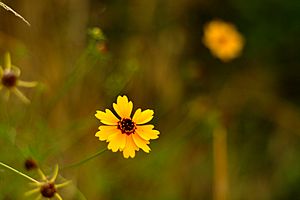Stiff greenthread facts for kids
Quick facts for kids Stiff greenthread |
|
|---|---|
 |
|
| T. f. var. filifolium | |
| Scientific classification | |
| Kingdom: | |
| (unranked): | |
| (unranked): | |
| (unranked): | |
| Order: | |
| Family: | |
| Genus: |
Thelesperma
|
| Species: |
T. filifolium
|
| Binomial name | |
| Thelesperma filifolium |
|
| Synonyms | |
|
Coreopsis filifolia Hook. |
|
Thelesperma filifolium, also known as stiff greenthread or plains greenthread, is a type of flowering plant. It belongs to the aster family, called Asteraceae. You can often find this plant growing in places where the soil isn't very deep.
Stiff greenthread likes dry, sandy, or rocky soil that has been disturbed, like along roadsides. It can grow in many different soil types, including loam (a mix of sand, silt, and clay), clay, and even a hard mineral layer called caliche. This plant usually blooms from March to June and sometimes continues into the fall.
Contents
Where Stiff Greenthread Grows
In Texas, you can spot stiff greenthread growing next to roads and on dry hills. It is common in the South Plains and Edwards Plateau areas. This plant also grows across many plains and mountain states. You can find it as far north as Wyoming, Montana, Nebraska, and South Dakota.
It grows very well on the lands of the Navajo, Hopi, and Pueblo tribes. You can also find it throughout much of New Mexico, Arizona, and Colorado.
What Stiff Greenthread Looks Like
Stiff greenthread has a long main root called a taproot. This helps it survive very dry weather, but it grows even better when it rains. The name "greenthread" fits it well because its leaves are thin and look like threads.
The plant can have one stem or many stems. It usually grows to be about 12 to 26 inches tall. Its leaves are spread out along the whole stem. The flowers look like daisies and are about 2 inches wide. They have eight golden-yellow petals. The center of the flower has many tiny reddish to dark brown disk flowers.
Before the flowers open, their buds hang downwards and are shaped like urns. The inner part of the flower bud is see-through. This allows you to see the colors of the flowers developing inside. When the flower opens, there are two types of small leaf-like structures at its base: one is short and green, and the other is longer and red.
Stiff Greenthread and Wildlife
The seeds of the stiff greenthread are a food source for the colorful painted bunting bird. Deer do not seem to eat this plant much.
This plant is also great for butterflies! It provides a place for butterfly larvae (caterpillars) to grow. Butterflies also drink nectar from its flowers. It is a food source for the larvae of the sulphur butterfly.
Uses of Stiff Greenthread
When you crush the leaves of stiff greenthread, they have a nice smell. People can make a tea from these crushed leaves. Some Native American tribes use this tea as a traditional medicine.
This use is very common among tribes in the southwestern United States. They call it by different names like Navajo tea, Hopi tea, or Indian tea.

